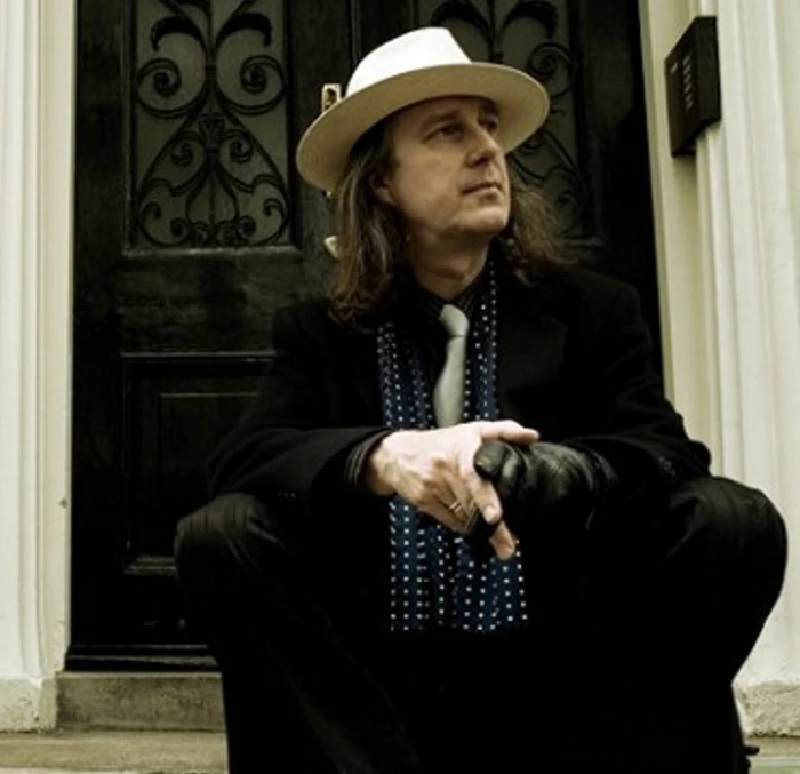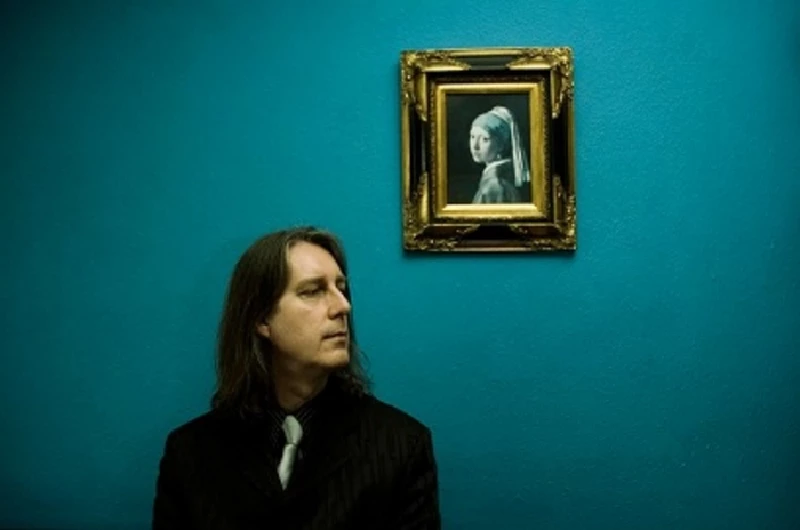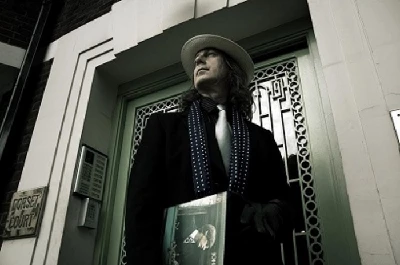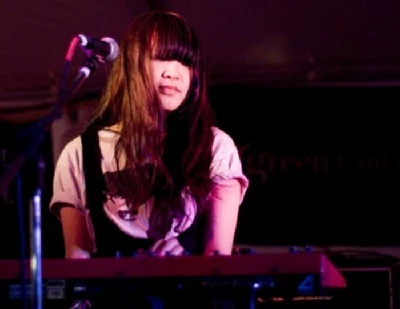Enuff Z'nuff - Interview Part 1
by Benjamin Howarth
published: 14 / 12 / 2013

intro
In a two-part interview, both parts of which we are publishing consecutively, rediscovered 70's singer-songwriter John Howard talks to Ben Howarth about his musical career, recent return to live work after an absence of several years and his latest solo album, 'Storeys'
On the video to 'Believe Me Richard' (the first single from John Howard's twelfth studio album 'Storeys') we see him descend the stairs to his studio room, at his home in Murcia (in south-eastern Spain) and are given a brief glimpse into his recording process – with his piano framed by a painstaking layer of guitars, bongos, cymbals and then strings, all recorded onto a portable Yamaha studio. Howard has recorded at the home he shares with his partner, retired actor Neil France, for several years now – and has continued to do so since moving onto the continent from his previous home in Pembrokeshire. Howard has decorated his studio with a Beatles 'Abbey Road' T-shirt, and pays direct to the Fab Four in the song's chorus, with the backing vocal line a remarkably accurate mimic of John, George and Paul's vocal harmonies. We also see a vinyl copy of his first album, 'Kid in a Big World' stacked on top of his piano. Unlike most Beatles fans, no matter how devoted, John Howard has actually made an album at Abbey Road himself. Recorded by Tony Meehan and Paul Phillips, and featuring guest turns from Rod Argent, 'Kid in a Big World' flopped on release – not helped by the BBC, who invented a series of increasingly bizarre reasons for refusing to play the singles – but has since been rehabilitated and was reissued by RPM to rave reviews (including a five star review in ‘Uncut’ and a glowing write-up in ‘The Guardian’). The belated success prompted further reissues for Howard's unreleased follow-up, and then a true comeback, with Howard releasing new material for the first time in thirty years. A string of further albums have followed. Pennyblackmusic spoke to John Howard two days before his first live performance in several years, supporting up-and-coming singer songwriter Ralegh Long at a gig at the Servant’s Jazz Quarters in East London, which also featured appearances from Robert Rotifer from Rotifer and Darren Hayman. Long has described John Howard as one of the main influences on his debut album, due to be released next year, and invited Howard to support him especially. In a forty five minute set, Howard switched comfortably between playful glam-pop and heart-rendering ballads, songs from his new album sitting comfortably alongside classics from his Abbey Road days. His easy stage manner made it seem like he had never been away. “I’ve always chatted to an audience”, he told me afterwards, “right back to when I played in folk clubs and at The Octagon Bluesologies in the ‘70s, it’s part of the whole thing for me, having a bit of banter with everyone. I never plan it but it always happens!” In the second part of this interview, we discussed Howard's thoughts now about his bad luck in the 1970s, and the motivations behind his return to songwriting. But first, I wanted to hear more about his new album, which had hardly left my stereo in the preceding weeks. PB: To begin, give me a bit of an introduction to the background to 'Storeys', and how you went about writing and recording it? JH: My songs tend to be a mixture of experiences I have had, experiences friends have had, stories I have heard and things I have read. I had always written story songs, featuring different characters, and I have always had a good response. They tend to be amongst my most downloaded songs and they seem to really appeal to people. It is something I have always enjoyed doing, right back to when I started in the 70s, so I thought, why don't we have a go at a whole album of songs where I put myself into someone else's life and someone else's position, and see what happens. I do like to put characters into scenarios and watch what happens. It is kind of like writing a screenplay really – you give the characters a start and watch what happens, and that's how I write. I just let songs happen once the idea starts to come. Then, that little play on words with stories and storeys – that just came to me one evening, and I got together with my sleeve designer, Naomi Carson, who did the sleeve, and she came up with a really lovely concept. A block of flats – so each character on the album lives in a different apartment of the building you see in the sleeve. It all came together, and that's how these things work. You come up with the germ of an idea, and sometimes things work and sometimes they don't. It was one of my quickest albums as well. PB: How long did the whole process take? I started in February, and I was finished by August. That for me is really quick. My previous album – 'You Shall Go to the Ball' – which included new versions of some of my older songs and then I wrote new 'soundscapes' to go around them. With those soundscapes, I was really starting from scratch, and trying ideas that I've never done before. It was completely new. That album took me more than a year. PB: When you write songs, is it the case that you have a few songs done, and then when you've worked out a theme, you pick songs that fit and perhaps rework them as appropriate? Or do you start at track one and write the album in one block? JH: The split between old songs and new was about 80:20. So, 80% were brand new, and 20% were based on bits of lyrics that I wrote some time ago, and had found in a box somewhere – an old idea I had that I couldn't work out what to do with. I'm a bit of a Woody Allen, I keep hundreds of scraps of lyrics. The first song on the album, for example. 'Believe Me Richard' – I wrote the opening lines to that years ago, but I didn't know what to do with them. But when I looked at those lyrics, the rhythm of the song always came to me, I didn't know what the tune would be, but I could always hear the rhythm. I don't know why I didn't finish writing that song two years ago – but when I started this album I found those lines and thought they would fit. I get a nag, really. Once I have finished an album, I usually have a few month's rest. I put everything away, I don't even look at the piano – nothing. And then, suddenly, germs of ideas for songs start to come – and I think, “Here we go. There is another album starting to appear here.” And this time, I took those lyrics out and the song came really quickly. I just sat down at the piano and it all came to me. I think that song and 'Permanently Temporary', which was a brand new song that came along quite early in the sessions for this album, both were songs that told stories about somebody else's lives. And that is where the idea for the album came from. Once the creative process starts to work – I move on from the period a couple of months earlier where if I had tried something it wouldn't have worked – and then I start to record, then it really is a domino effect. It all starts to happen. Then I carry on writing and recording until I have the album finished. PB: Do you work on just one album at a time? I'm thinking of someone like Paddy McAloon from Prefab Sprout, where he has piles and piles of old recordings and albums he has made that have never been released. Is that how you work – or do you finish one album and release it before you think of the next one? JH: I do one album at a time. I am very bad at multi-tasking on anything, really. So, preparing for this gig – I am just concentrating on that at the moment. I had actually just started working on another album when the idea for this gig came up, which is very unusual for me – to go from finishing one album to working on another within a week, but I have put that on hold, and concentrated on practising for the gig. But I do just focus on one project or idea at a time. Once I am working on an album, I am just stuck down in my studio for days and weeks at a time. My partner, Neil France, he becomes a bit of a studio widow really. I just come upstairs to watch ‘Doctor Who’, and go back down again. I think I have always been like that – but the difference now is that as I have a studio at home, I'm never constrained by how often I can go into the studio. I can now record whenever I want. I've just got all the time in the world. PB: Do you split the process of writing and arranging the song – do you have the basic tune, and then do the arrangements and backing vocals when you have a clearer idea of what the album as a whole will sound like? JH: I finish each track before I start the next. Right back to when I did 'Kid in a Big World' with Tony Meehan, that is how we worked then. We literally did a track at a time. We probably did a couple of tracks a day, if I remember rightly, because we were on limited time. But I still work that way – that's the way I like to work, I'm not comfortable zig-zagging around. I need to know that a song is finished, and that I am happy with it, before I can move on to the next. PB: One of the other aspects to this – I talked about when I reviewed ‘Storeys’ for Pennyblackmusic – is that now, you work from home in what is not an Abbey Road setting... JH: (Laughs) You've seen my video to “Believe Me Richard”, then... PB: And yet, there is a lot of intricate detail on the recordings. There are string arrangements and multi-layered backing vocals. You recorded everything yourself, but I wondered how much of your 'studio expertise' is self-taught, based on trial and error? Or have you worked in other studios and learned the techniques? JH: I have a little Yamaha studio. An amazing little machine. It was actually Darren Hayman who had one (Howard appeared on Darren Hayman's 2007 'Secondary Modern' album – Ed.), and also the drummer who backed me on a couple of gigs that I did in 2004. He actually had one. So ,I went out and got it. But, I have to be honest. Technology and me are not always great with one another. I battled with this machine for six months, and I was on the point of selling it on eBay. I just couldn't get started – I just couldn't work out what to do. Because I was so used to working in the old way, of seeing physical things. By the time I decided to try and do it myself – 'Barefoot with Angels' was the first album I recorded at home – I kept reading the manual, and couldn't work out what to do. So basically, in the end, I just pared the manual down into bullet points. I stopped bothering to read the bits in between. But every album I have done since then, I have learned something else. I've worked out better EQs or a better way of panning strings, so you get a much rounder 'orchestra' sound – not just a few strings twinkling away in the background. It might just be because it is my most recent one – and you always love your most recent work – but it just seems to all come together on this album. Everything just seems very in place. When I listen to my older work, there are little sections that I wish now I could have done differently. But that's how it should be – you shouldn't just be sitting there planning to do the same old thing every time. When I worked with Tony and Paul back in the 70s, I had no interest at all in the recording process. I just sat, played the keyboards and the piano, added a bit of Mellotron – they had that at Abbey Road, great fun – and then the vocals, and then I went downstairs to the canteen, had a coffee while they mixed it. When I look back on that, it's quite odd, because I'm so fascinated now. The whole process – thank goodness, because there's noone else who can do it for me (Laughs). PB: You've talked about plans for your next album, and I'm assuming you intend to make plenty more. Do you think you will continue to work at home, or do you have an ambition in the back of your mind to work with a different producer again at some stage? JH: I think if you had asked me that question a few months ago, I'd have said I'd stay just working at home. And I probably still would overall now – I love that luxury of not having to work to anybody else's timetable. But I think Robert Rotifer would like to do something with me, and the band that I'm playing with on Wednesday night (Andy Lewis on bass and Ian Button on drums). I would love to do something with them – I think it would be done fairly quickly, because they are all excellent musicians who work with bands all the time? We wouldn't be sitting around for days on end wondering what to do. We have danced around the idea, Robert and I, and maybe the gig on Wednesday could be the start of working in a different way. I'm up for that – because it's never a good idea to get too comfortable or too complacent. BH: So this gig on Wednesday is the first time you will have played with Robert, Andy and Ian. Where did this relationship come from? JH: It's like everything else with me, everything happens quite organically. I saw an article on the Neon Filler site, where Ralegh Long had said that I was one of his biggest influences, and I didn't know Ralegh's music at that point. So, having read that article, I sent a copy of my last album to Joe Lepper at Neon Filler, and then he said – out of the blue – that I should really send a copy of the album to Robert Rotifer, I think he would love this. Robert did an interview with me for his FM4 radio show that he does in Austria, and he asked me then if I would consider gigging again. I thought that I would, but I would be nervous about headlining – as I was worried that it had been too long since I had played to be sure to draw a crowd, it would just be three people and an Airedale. So I said that, if I did do something, it would need to be as a support act, I would feel more comfortable with that. It would be like suck it and see – put your toe in the water and see what happens. So, Robert got back to me later and said that Ralegh Long wants to do a show at the Servant Jazz Quarters, it is quite a small venue, would you consider coming along and playing. I said yes – so that then started, and then – a few days later, little devil that he is, he emailed me and asked if he could play guitar with me on one of the numbers. He suggested 'Don't It Just Hurt?', because he had just recorded his version of that song for the 'Ebbsfleet International' compilation. I thought it would be great, especially as he'd done a cover. Then, a few days later, he emailed again and asked “how do feel about having a band?” He said he had mentioned the gig to Andy Lewis and Ian Button, and they both wanted to play. I did a similar thing when RPM released 'Kid in a Big World'. That was a band that RPM put together for me – I had never played with them before, we did a couple of hours the day before, did the soundcheck and just played. It always amazes me how these guys do it, because I am not that kind of musician, I can't jam. I'm awful in those situations – if I don't know exactly how it goes, I'm useless. Which is probably why I have never actually been in “a band”. Why I have always been solo – I'm not a musician's musician. Whereas Andy, he gets an email from Paul Weller and is told, here is a demo, we're recording in two days, you're there at 12 o'clock. And he just does it. Well, that would terrify me. PB: In terms of your musical background, you are classically trained to play piano? JH: Yes. PB: And then there is a whole range of other instrumentation on the album, and you played it all yourself. How much of that is self-taught? JH: All of it. For example, the percussion is done a bit at a time, obviously. It's not a drum kit – it's a snare drum, cymbals, maracas, bongos... all sorts of stuff. And I just layer it up. But that's a good thing, in a way, for me, because it just means that if part of it doesn't work, you can just delete it and do something else. A friend of mine, a singer-songwriter as well, emailed me the other day and said that what they loved about the song, 'Believe Me Richard', is that on the percussion, it's obvious that you are not a drummer, but that is what works about it. I don't do things the normal way. My mastering engineer, Tony Shepherd, who has mixed all my albums for the past ten years or so, he calls me a sweet old thing. He says that I am doing manual mixing, with manual fading and panning. He finds it funny that I don't do that with computers and get all of that sorted before I start. But that is where I am from. I am from the sixties, and was a Beatles fanatic from the mid-sixties onwards, and I loved their process of recording. Even though they had Abbey Road at their disposal, it was a pretty primitive studio when they were there. I love the way they would just block book it for months on end, and if something didn't work, they would just come back and try again the next day. For me, it's the fun of recording. In the 80s, I worked with a few producers who did things very digitally. The guitarist would play three notes and they would spin it into the chorus every time. I just used to sit there astonished – it's dead easy, but where's the fun? PB: I wrote about this when I reviewed ‘Storeys’ as well. It did remind me of the Beatles, where they had a very primitive set-up, but that forced them to think of clever ways to get what they wanted. Like, there is a World War Two air raid shelter at Abbey Road, and they worked out that if they went in there they could get the drum sound to sound perfect. It's slightly different for you because you don't have a space like that, but you do get the impression that you are finding a way to get to the sound that you want – rather than just hiring an orchestra and getting them to do it. JH: That's right. It is also the Brian Wilson technique, of playing the same notes at the same time, so you are never quite sure what the instrument is. I used to love that, you could never tell what the sounds were – but it was because he had five different instruments all playing the same note at once, and the harmonics were all bouncing off one another. I try and do that sort of thing – where it is a bit of a mystery at time what is happening. Sometimes I am just banging a cardboard box. But I would rather do that than just find a sample – it is half the fun of recording.
Picture Gallery:-


interviews |
|
Interview Part 2 (2013) |

|
| In 1975, CBS Records released 'Kid in a Big World' – a sumptuous fusion of glam-rock, sixties pop and orchestral showtunes. It was the first album by John Howard, a singer songwriter who had learned h |
live reviews |
|
Manchester University, Manchester, 4/12/2009 |

|
| At an atmospheric gig at Manchester University, Dixie Ernill sees New York-based and C86-influenced band the Pain of Being Pure at Heart play a lively and exuberant set of pop/rock |
most viewed articles
current edition
John McKay - InterviewCathode Ray - Interview
Robert Forster - Interview
When Rivers Meet - Waterfront, Norwich, 29/5/2025
Spear Of Destiny - Interview
Fiona Hutchings - Interview
Carl Ewens - David Bowie 1964 to 1982 On Track: Every Album, Every Song
Chris Wade - Interview
Shrag - Huw Stephens Session 08.12.10 and Marc Riley Session 21.03.12
Brian Wilson - Ten Songs That Made Me Love...
previous editions
Heavenly - P.U.N.K. Girl EPBoomtown Rats - Ten Songs That Made Me Love....
Manic Street Preachers - (Gig of a Lifetime) Millennium Stadium, Cardiff, December 1999
Allan Clarke - Interview
Oasis - Oasis, Earl's Court, London, 1995
Barrie Barlow - Interview
Beautiful South - Ten Songs That Made Me Love...
Pixies - Ten Songs That Made Me Love...
Chuck Prophet - Ten Songs That Made Me Love...
Dwina Gibb - Interview
most viewed reviews
current edition
Peter Doolan - I Am a Tree Rooted to the Spot and a Snake Moves Around Me,in a CircleVinny Peculiar - Things Too Long Left Unsaid
Garbage - Let All That We Imagine Be The Light
Vultures - Liz Kershaw Session 16.06.88
John McKay - Sixes and #Sevens
Little Simz - Lotus
HAIM - I Quit
Pulp - More
Lapsley - I'm a Hurricane, I'm a Woman In Love
Billy Nomates - Metalhorse
Pennyblackmusic Regular Contributors
Adrian Janes
Amanda J. Window
Andrew Twambley
Anthony Dhanendran
Benjamin Howarth
Cila Warncke
Daniel Cressey
Darren Aston
Dastardly
Dave Goodwin
Denzil Watson
Dominic B. Simpson
Eoghan Lyng
Fiona Hutchings
Harry Sherriff
Helen Tipping
Jamie Rowland
John Clarkson
Julie Cruickshank
Kimberly Bright
Lisa Torem
Maarten Schiethart